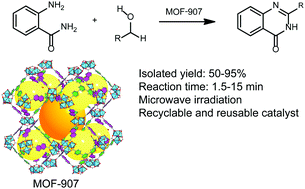Effect of Fe(iii)-based MOFs on the catalytic efficiency of the tandem cyclooxidative reaction between 2-aminobenzamide and alcohols†
Abstract
The catalytic properties of metal–organic frameworks (MOFs) containing triangular Fe(III) clusters in the promotion of organic syntheses and photocatalysis applications have been receiving substantial attention for decades. These clusters are appealing due to the strong Lewis acidity afforded by coordinatively unsaturated sites upon the removal of solvent from the framework. In this paper, triangular Fe(III) cluster-based MOFs were shown to be highly efficient heterogeneous catalysts for the solvent-free one-pot condensation of 2-aminobenzamide and alcohols to form quinazolin-4-ones under microwave irradiation. The Fe-MOF catalysts ranging from microporous to mesoporous structures with a variety of geometrical pore structures were investigated. Because of the open accessible spaces for reactants and high density of active sites, MOF-907, built from trimer Fe clusters and a mixture of two linkers, was more effective than other Fe(III)-MOFs. The catalyst can be used for a broad substrate scope and recycled several times without a significant drop-off in its activity.



 Please wait while we load your content...
Please wait while we load your content...